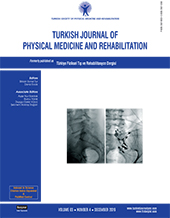Functional outcomes after flexor tendon repair of the hand
2 Department of Occupational Therapy, Faculty of Health Sciences, University of the Witwatersrand, South Africa
3 Department of Biostatistics, South African Medical Research Council, Pretoria, South Africa DOI : 10.5606/tftrd.2019.2137 Objectives: This study aims to evaluate the hand function after flexor tendon repair (FTR) and to investigate factors associated with functional outcomes.
Patients and methods: Between January 2013 and September 2015, a total of 126 patients (84 males, 42 females; mean age 31 years; range, 15 to 62 years) who underwent FTR due to flexor tendon injuries (FTIs) were included. The hand function was assessed using the Jebsen Hand Function Test (JHFT) and Quick Disabilities of the Arm, Shoulder and Hand (Quick DASH) at three and six months following FTR.
Results: Of the patients, 94 (75%) and 72 (56%) completed the three-month and six-month assessment visits, respectively. A total of 65 patients (51.1%) had both three and six-month follow-up data. The patients regained a fair amount of power grip strength and more than half of their pinch grip strength compared to the unaffected hand. The results of assessment of hand function at activity and participation levels (JHFT and Quick DASH) showed slightly higher levels of disability. Of 41 patients who were employed prior to injury, 29 (71%) returned to work at six months after surgery. Zone IV injury and language barrier were associated with poor functional outcomes at six months.
Conclusion: Our study results showed that the JHFT and Quick DASH scores of the patients were less than the established norms, although functional outcomes improved over time. Based on these results, we suggest that the presence of zone IV FTI and language barrier are associated with poor functional outcomes.
Keywords : Flexor tendon repair, functional outcomes, hand function

















